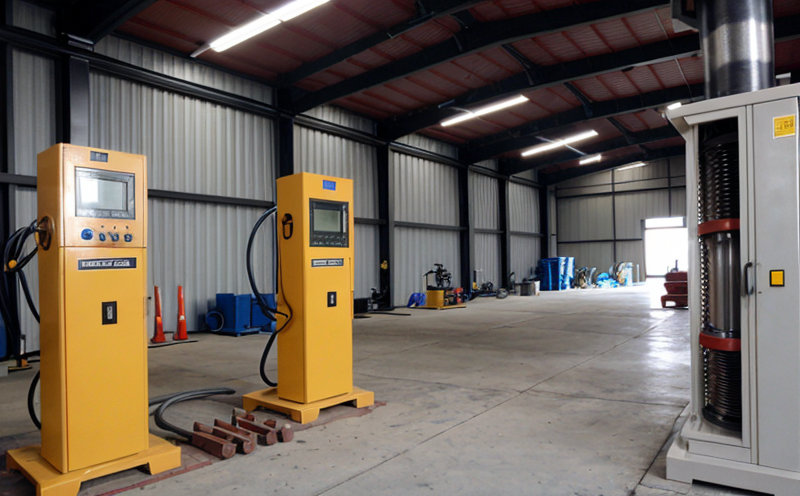ISO 12048-7 Compression Testing with Environmental Conditioning
The ISO 12048 series of standards provides comprehensive guidelines for the mechanical testing of packaging materials and systems. Specifically, ISO 12048-7 addresses compression testing under controlled environmental conditions to ensure that packaging is robust enough to withstand real-world stresses during transportation and storage.
The test aims to simulate the mechanical loading experienced by packaging in transit or on store shelves. This includes compressive loads, stacking pressures, and environmental factors such as temperature and humidity. Understanding these parameters helps manufacturers design packaging that meets both functional requirements and regulatory standards.
During compression testing, specimens are subjected to a controlled load applied axially along the axis of the test specimen. The objective is to determine the point at which the package fails or deforms beyond acceptable limits. This failure point indicates the material's strength and the potential for damage under stress.
The environmental conditioning aspect involves exposing the packaging to specific temperature and humidity conditions before, during, and after compression testing. These conditions simulate real-world environments where packages are likely to be exposed. For instance, a package intended for shipment in a hot climate may experience significant thermal expansion followed by rapid cooling upon arrival, leading to stress on the packaging.
By incorporating environmental conditioning into the test, manufacturers can assess how well their designs perform under varying conditions, ensuring they meet quality and safety standards. This is particularly important for industries dealing with perishable goods or those that require compliance with specific regulations.
The testing process involves precise specimen preparation to ensure accurate results. Specimens are cut from the packaging material according to standard dimensions provided by ISO 12048-7. The specimens must be representative of the actual packaging design, including any layers or structural elements that contribute to its overall strength.
The testing apparatus used for this type of compression test typically consists of a hydraulic or mechanical press capable of applying controlled loads. Sensors monitor load and displacement throughout the test. Environmental chambers control temperature and humidity levels as specified in the standard.
Acceptance criteria for passing the test vary based on the specific application and intended use of the packaging. Generally, the package must not deform beyond a certain threshold under the applied compressive force. Additionally, it should maintain its structural integrity without compromising contents or requiring replacement during transport.
In industries where product safety is paramount, such as pharmaceuticals or food manufacturing, ensuring that packaging can withstand high-pressure conditions without failure is crucial. The test results provide valuable insights into material selection and design optimization for improved performance across various environments.
Why Choose This Test
Selecting ISO 12048-7 compression testing with environmental conditioning offers several advantages. It helps manufacturers ensure their packaging meets stringent quality and safety standards, thereby enhancing customer satisfaction and brand reputation.
This type of testing is essential for industries handling fragile goods or those that require compliance with specific regulations. By incorporating environmental conditions into the test, it provides a more realistic assessment of how packages will perform in real-world scenarios.
The detailed information provided by these tests enables companies to make informed decisions about material selection and design improvements. It also helps them stay ahead of industry trends and regulatory changes.
For quality managers and compliance officers, this test offers a reliable method for validating packaging designs against international standards. For R&D engineers, it provides critical data for iterative improvement processes aimed at enhancing product performance.
In summary, choosing ISO 12048-7 compression testing with environmental conditioning ensures robustness in packaging design while meeting both functional and regulatory requirements.
Environmental and Sustainability Contributions
Evaluating the environmental impact of packaging through rigorous testing like ISO 12048-7 compression tests contributes significantly to sustainability efforts. Understanding how different materials behave under stress can lead to more eco-friendly designs that balance performance with reduced resource consumption.
By identifying optimal material combinations and configurations, companies can minimize waste by producing only the necessary amount of packaging needed for each product type. This approach reduces environmental footprint while maintaining operational efficiency.
The insights gained from these tests also facilitate better communication between stakeholders involved in supply chain management, helping to align efforts towards sustainable practices. For example, suppliers can work closely with manufacturers to select raw materials that not only meet performance requirements but are also environmentally responsible.
Moreover, the test results contribute to regulatory compliance by ensuring that products comply not just with current rules but anticipate future developments in environmental legislation. This proactive stance positions organizations as leaders in sustainable practices within their respective sectors.
Use Cases and Application Examples
This testing method finds applications across various industries, including food and beverage, pharmaceuticals, electronics, and consumer goods. Here are some specific use cases:
- Food and Beverage Industry: Ensuring that containers used for transporting perishable items like dairy products or fresh produce can withstand the rigors of transport without compromising product integrity.
- Packaging Manufacturers: Developing new materials or modifying existing ones to meet specific performance criteria while adhering to environmental sustainability goals.
- Pharmaceutical Industry: Verifying that blister packs and other packaging solutions protect medications from damage during handling and storage conditions.
These tests are particularly valuable for companies involved in international trade, where compliance with multiple regional standards is necessary. By conducting thorough compression tests under varying environmental conditions, businesses can ensure their products meet global regulatory requirements without compromising quality or sustainability.





